Share
Working at ESO
Are you interested in working in areas of frontline technology and in a stimulating international environment? Do you feel your profile matches our requirements? Learn more about our current vacancies and apply online. Read more..
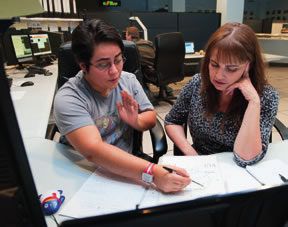
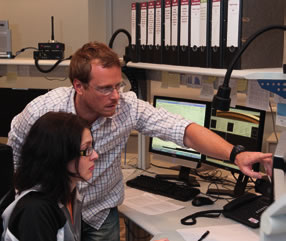
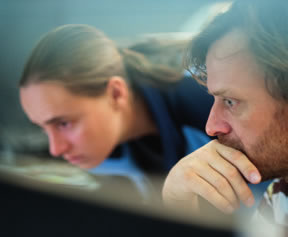
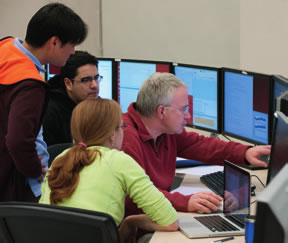
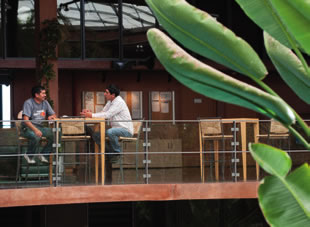
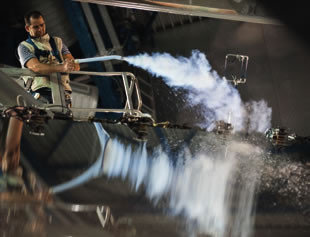
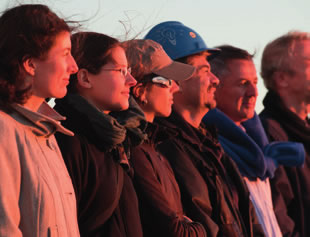
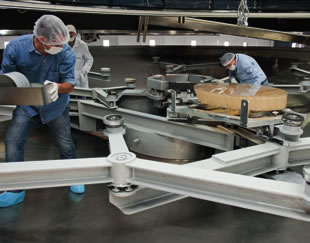
The European Organisation for Astronomical Research in the Southern Hemisphere (ESO) is the foremost intergovernmental astronomy organisation in Europe and the world's most productive ground-based astronomical observatory. ESO carries out an ambitious programme focused on the design, construction and operation of powerful ground-based observing facilities enabling astronomers to make important scientific discoveries.
ESO operates three unique world-class observing sites in northern Chile: La Silla, Paranal and Chajnantor (home to ALMA), and the ESO Headquarters are located in Garching, near Munich, Germany.
At Paranal, ESO operates the Very Large Telescope, the world's most advanced visible-light astronomical observatory, and will host and operate the southern array of the Cherenkov Telescope Array, the world's largest and most sensitive high energy gamma-ray observatory. ESO is a major partner in ALMA. On Cerro Armazones, ESO is building the 39-metre Extremely Large Telescope (ELT), which will become "the world's biggest eye on the sky" and whose operations will be fully integrated into the Paranal Observatory.
For its Paranal Observatory, ESO is inviting students from Chilean universities, ideally those in their final year(s) of studies, to apply to our program:
For the summer period 2026 starting early January, ESO is offering five projects for the Maintenance, and Engineering Department (MSE), and five projects for the Paranal Science Operations Department (PSO). Below is a brief description of each of these departments, followed by the projects available.
The Maintenance, Support and Engineering Department (MSE): provides technical support to the four VLT 8-m telescopes, to the VLT Interferometer with its auxiliary telescopes and to all instruments available for scientific observations. The MSE Department of Paranal has a total workforce of 80 engineers and technicians distributed in six engineering groups. References for MSE Dpt. http://www.eso.org/sci/facilities/paranal/paranalenginternship.html. See also the podcast about engineers working at ESO: https://www.eso.org/public/videos/esocast186a/
The Paranal Science Operations Department (PSO) consists of 60 persons of more than a dozen different nationalities. PSO's mission is the production of high-quality astronomical data and to maintain or improve the scientific performance of Paranal's instruments. This includes the VLTI 2nd generation instruments Gravity & Matisse, the Adaptive Optics Facility (AOF) on UT4 and the planet hunter ESPRESSO.
List of Projects MSE Department:
I. Mechanics Project "Technical evaluation of replacing inflatable seals by brush strips"
During day-time the telescopes of Paranal are closed and stopped in a parking position, and we use inflatable seals in order to seal the gap between movable and fixed parts of the enclosures of the telescopes. The main goals of the inflatable seals are:
- Avoiding the entrance of rain and high humidity during bad weather conditions.
- Avoiding the entrance of dust and sand coming from desert during high winds
- Avoiding the entrance of sun light/rays during day-time, to create a dark environment inside the enclosure for the calibrations of the observation instruments
We want to evaluate if replacing the inflatable seals by plastic brushes strip may be a technical option, for this we need to carry on a study considering the following:
- Designing, and with the support of the Paranal Machinery Workshop, implementing a test bench to simulate the seal condition and technically evaluates the brushes strip as a technical solution to replace the inflatable seals.
- Developing and implementing a criteria to measure the effectiveness of the brushes for blocking the pass of humidity, water and light.
- Measuring the frictions/forces needed to displace the fixed vs the movable surfaces covered/interfaced by the brushes, and extrapolating it to the Enclosure condition, i.e. to 100 mt perimeter length. Estimating the increase of torque and power, that would be required for the motors of the Enclosure rotation system.
- Applying previous criteria and conditions for the brushes subjected to different level of compressing forces/pressures.
- The durability, to estimate the degradation duration of the elastic properties of brushes bristle.
- Determine if it would be advisable and/or necessary to use one or more brushes row in parallel.
- Proposing a low impact design and procedure to replace current inflatable seal by the brushes strip.
Student Profile:
- Execution or Civil Mechanical Engineer.
- Mechanical Technician from a Professional Institute or University
- Drawings in Autodesk Cad or Inventor files
Shift and Duration:
The schedule will be eight days on duty and six days off duty (8x6) with accommodation provided on site. The internship will last for two months, January and February.
II. Software Project "Enclosure and hydrostatic bearing system LCU replacements"
The Unit Telescopes at the Paranal Observatory are already 25 years old, and in the context of the Obsolescence management, we try to remove the VME control systems. The Enclosure and Hydrostatic bearing system Local Control Unit (LCU) are simple systems that can be completely replaced by processes on a Worskstation and opcua communication technology.
The work is done with support from electronics group that will provide the signal maps and enable opcua on the PLC used to replace this system. For the student it will be a good opportunity to know PLC technoplogy, SW development cycle and communication protocols. Two interns will be selected to work on each system (enclosure and hydrostatic bearing system).
Student Profile:
- Software engineer student in the last years of the career.
- Python, C, Linux and Git knowledge.
Shift and Duration:
The schedule will be eight days on duty and six days off duty (8x6) with accommodation provided on site. The internship will last for two months, January and February.
III. Electronics Project "Recovery of electronics boards for telescope systems"
The project is about recovering VME boards used in our various controls systems. Electronic board fails and need to be repaired, in particular when there a few spares left due to obsolescence reasons. The intern will work in the Paranal laboratory to test and fix VME boards for the Linear Motor Control Units of the interferometer delay lines. The repaired boards will be validated in a test bench and the work will be documented to ease future repairs. Work will include understand the design of the board, define how to test it and replace components.
Student Profile:
- Electronics engineering, preferably in the last year of university and with practical lab experience with electronic boards
- Electronics Technician with experience in repairing electronic devices.
Shift and Duration:
The schedule will be eight days on duty and six days off duty (8x6) with accommodation provided on site. The internship will last for three months, January through March.
IV. Instrumentation Project "Improving the Condition-based Maintenance of Laser Guide Star Units"
The intern will contribute to experimenting/testing different preventive and predictive maintenance strategies for Laser Guide Star Units that are part of the Adaptive Optics infrastructure at ESO's Very Large Telescope (VLT) on Cerro Paranal. These units are used to generate artificial guide stars by projecting powerful sodium lasers into the sky, exciting sodium atoms in the Earth's mesosphere at around 90 km altitude. These artificial stars serve as reference points for the adaptive optics systems, allowing real-time correction of atmospheric turbulence and delivering sharper astronomical images. The student shall assess the existing telemetry data to identify the most relevant parameters and propose different predictive or condition-based maintenance strategies. ML techniques are envisaged. Once the strategy is defined, the student shall support the integration into the existing digital architecture, including the use of the internal Datalab and creation of work orders/job plans. The intern might also participate in the commissioning of the new laser test bench and define periodic tests and maintenance plans for that facility.
Student Profile:
- Engineer preferably from Electronics or Software career
- Data gathering and analysis, modelling and simulation
- Ideally some knowledge of astronomical instruments (at basic level)
Shift and Duration:
The schedule will be eight days on duty and six days off duty (8x6) with accommodation provided on site.The internship will last two to three months (January-March).
V. IT Project: "TIG Upgrade and automatization"
The project aims at updating our current TIG stacks for Santiago, Paranal and La Silla and also to provide a solid base to start automating network tasks. We expect all systems to be updated to their latest versions, the monitoring parameters reviewed eliminating the unnecessary ones and adding those that could provide value. In addition a base configuration to automate tasks on network devices should be created, this environment should include complete network devices inventories, libraries and other necessary files.
Student Profile:
- IT Technical career
- Understanding of routing and switching technologies, particularly using Cisco Equipment.
- Understanding of network related cybersecurity
- Automation and monitoring skills, handling of Python, Telegraph, InfluxDB and Grafana
- Basic Linux experience
Shift and Duration:
The schedule will be eight days on duty and six days off duty (8x6) with accommodation provided on site. The internship will last for two months, January and February.
List of Projects PSO Department:
I. "Pointing Monitoring Using Science Presets"
This project investigates improvements to the maintenance of pointing procedures for the Paranal Unit Telescopes (UTs). The approach is to use standard presets as a consistent source of pointing data, enabling daily monitoring of on-sky performance and supporting continuous refinement of the pointing model. The required variables to produce a standard pointing data file have been identified and will be incorporated into the daily log file. In addition, the logs include environmental parameters that can be used to train algorithms to generate monitoring metrics and define thresholds (for example, to decide when a new pointing run is required). The student will help curate a comprehensive dataset for analysis and will participate directly in the observation process. This involvement will provide practical exposure to both the mechanical and software aspects of telescope operation, while contributing to a tangible improvement in observatory procedures
Objectives:
- Gain familiarity with the observation process and the concept of pointing.
- Become acquainted with the log files, as well as the existing tools and databases already in use.
- Propose and investigate the suitability of new analysis and monitoring approaches, with emphasis on data visualization.
- Produce a comprehensive report and, ideally, deliver a piece of code either as an improvement to existing tools or as a new standalone utility.
Student Profile:
- Software or Mathematics Engineering student with hands-on experience in ML software packages and tools.
- Proficiency in the English language.
- Essential understanding of astrometry and celestial mechanics.
Shift and Duration:
8x6 shift. 1 January - 31 March 2026. The schedule will be eight days on duty and six days off duty (8x6) with accommodation provided on site. The internship will last for three months, from 1 January to 31 March 2026.
II. "Setup and testing of an earthquake early alert detection system"
This project consists of the implementation and testing of a system estimate the strength of an incoming seismic event and trigger an alert if this event is of high risk. The system consists of a combination of hardware and software work. The hardware (seismograph and high frequency signal sampling device) is available.
Objectives:
This project consists of the following stages:
- Get familiar with the available hardware and the main goals of this summer project. The hardware includes a 3-axis accelerometer, a digitizer, GPS timing, and an embedded linux OS.
- Connect the hardware for testing of communication and data acquisition.
- Extract the digitized signal as this is being produced (primary seismic wave).
- Real-time processing of the data and compute some basic statistics
- Relate the measured statistics on the primary seismic signal to the expected peak-ground-acceleration (PGA) of the incoming secondary seismic wave.
- Check the estimated PGA with our seismic risk thresholds
- The goal is to trigger an alert for the case the upcoming secondary wave is expected to be of high-risk.
Student Profile:
The student shall have a background on electronics engineering with experience in python and C programming languages. The student will work on a real-time processing system, reading data directly from a digitizer. Ideally a student in the latest year of their engineering education plan (4th year or beyond). Willingness to work on a shift schedule, including occasional night shifts.
Shift and Duration:
The schedule will be eight days on duty and six days off duty (8x6) with accommodation provided on site. The internship will last for two months, from 15 January to 15 March 2026.
III. "Performance analysis of meteorological and atmospheric turbulence forecast data"
This project consists of the to compute the accuracy of meteorological and atmospheric turbulence forecast data. The accuracy of the forecast data is checked against the observations. The forecast accuracy will be verified for various levels of data aggregation, including: hourly, 3-hours, and nightly/daily averages.
Objectives:
This project consists of the following stages:
- Get familiar with the available forecast and observations data
- Re-sampling of the forecast and observations data series to a common time resolution (hourly, 3-hourly, nightly/daily averages, etc.)
- Compute the accuracy of the forecast using the Contingency Matrix approach, for given intervals of the various meteorological and atmospheric turbulence variables considered in the study
- Produce a presentation and final report with the results of this forecast accuracy study
Student Profile:
Ideally, the student shall have a background on meteorology or any related atmospheric sciences, with good skills for descriptive and inference statistics. Preferably a student on an advance level of their university education program.
Shift and Duration:
The schedule will be eight days on duty and six days off duty (8x6) with accommodation provided on site. The internship will last for two months, from 15 January to 15 March 2026.
IV. "Selecting new astrometry fields for MUSE calibrations"
MUSE is one of the most advanced integral field spectrographs available to the astronomical community and one of the most requested instruments at the Observatory. Its success relies on a robust calibration plan to monitor instrument performance and ensure accurate data reduction.
Astrometric calibration is a key component, providing a precise mapping between the instrument's field of view and the sky by observing dense stellar fields with well-known positions. However, due to the target protection of the GTO team, the current set of calibration fields is limited, often forcing observations under suboptimal conditions due to the lack of suitable targets at specific times of the year.
This project aims to identify additional astrometric calibration fields to improve scheduling flexibility, efficiency, and calibration quality throughout the year. The selected candidate will analyze stellar catalogs, evaluate field suitability, and deliver an expanded set of targets for routine calibration observations with MUSE.
Objectives:
- Identify new globular cluster fields with HST observations with suitable characteristics for astrometric calibration in both the wide and narrow field modes of the instrument.
- Build precise star catalogs for each selected field.
- Add the catalogs to the MUSE pipeline
- Plan and execute the necessary observations.
- Reduce the data, ensuring correct processing modes are used.
- Validate the calibration results.
- Design the final calibration OBs for inclusion in the standard calibration queue.
- Test the OBs to confirm proper execution and pipeline recognition.
- Document the process.
Student Profile:
- Student of Scientific career (e.g., Physics, Astrophysics)
- Familiarity with the basics of astronomical observations
- Working knowledge of Python and its astronomy related packages
Shift and Duration:
January until early March. Two shifts on-site, rest mobile or at Vitacura office.
V. "ETC queries through SCUBA"
Every ESO instrument is accompanied by a dedicated tool known as an Exposure Time Calculator (ETC), which helps astronomers prepare their observations. The primary function of an ETC is to estimate the exposure time required to achieve a desired signal-to-noise ratio (SNR) for a given astronomical target (e.g., a star, galaxy, etc.). The goal of this project is to support the development of a Python-based script that automatically compares ETC predictions with real observational data. This tool will programmatically evaluate observing blocks during operations and determine whether the acquired data meet quality control standards or need to be repeated. This work is part of a broader initiative to automate operations at Paranal Observatory, within the framework of the Integrated Operations Programme (IOP)
Objectives:
- Implement ETC script for the FORS2 instrument within Paranal's SCUBA infrastructure for quality control
- Improve code readability and structure (cosmetic and stylistic refinements)
- Contribute to the development of the associated GitLab unit testing pipeline
- Extend the pipeline to support additional features or improve existing ones
- If a new instrument ETC is released before the start of the internship, the student will star implementing a new script for that instrument.
Student Profile:
- Student of Scientific career (e.g., Physics, Astrophysics) or Computational/Software Engineer
- Knowledge of Python language
- As a plus (not mandatory): be familiar with astronomical and spectroscopic data in the FITS format
Shift and Duration:
January until early March. Two shifts on-site, rest mobile or at Vitacura office.
Duty Station
Paranal Observatory, located 120 km south of the city of Antofagasta, Chile.
Contract Allowance and Transportation
ESO offers a special allowance during the period of the internship. Air and ground transportation between Santiago and the observatory site will be provided by ESO.
Application
We invite students from Chilean Universities, ideally in their last career years to apply. The apprenticeship should be supported by the University, and therefore, it shall be covered by the student accident insurance (Law 16.744). Applications must be completed in English and should include a CV and a motivational letter indicating the project(s) -name and number- you are interested in.
Interviews will be conducted in English.
Closing date for applications is 27 October 2025.
ESO Values
An important element in any successful employment relationship is harmony in values between an organisation and its people.
The ESO Values are:
ESO strives for excellence through innovation.
ESO provides outstanding services to its communities.
ESO fosters diversity & inclusion.
ESO believes in the key role of sustainability for its future.
Achieving the above are recognized as only possible on the basis of personal values and attitudes that we expect from our employees: respect, integrity, accountability, commitment, collaboration, and clear & open communication.
Applicants to any ESO role are asked to reflect on their affinity with these values and advised they may be asked about them if called for interview.
Diversity
ESO has established diversity as an important value of the Organisation, is committed to providing an equal opportunities environment and is actively seeking to promote a diverse, equitable and inclusive workforce. Please visit https://www.eso.org/public/about-eso/sustainability/dei-at-eso/ for further details.
